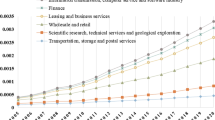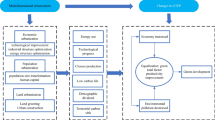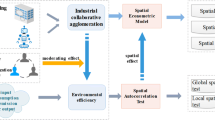Abstract
This paper explores the impact of population agglomeration on urban economic development quality in various cities of China. The results show that population agglomeration significantly contributes to the improvement of urban green total factor productivity by increasing population diversification, promoting knowledge spillovers, and reducing pollution emission intensity. Moreover, we find that population agglomeration in type II big cities and type I large cities significantly improves green total factor productivity, while the impact of population agglomeration in metropolises and mega-cities on green total factor productivity is not significant. On the one hand, type II big cities and type I large cities are in the period of rising economic development, the population has not yet reached saturation, and there is still a large demographic dividend space. On the other hand, excessive population agglomeration also brings about “urban diseases” such as population congestion and traffic congestion, especially in the metropolises and mega-cities. Finally, using data on producer services and its sub-sectors, we identify a more significant driving effect of high-end talent agglomeration on green total factor productivity.
Similar content being viewed by others
Data availability
Not applicable.
References
Acs Z, Sanders M (2021). Endogenous Growth Theory and Regional Extensions. In: Fischer, MM, Nijkamp, P (eds) Handbook of Regional Science. Springer, Berlin, Heidelberg, pp 615-634. https://doi.org/10.1007/978-3-662-60723-7_13
Alesina A, Ferrara EL (2001) Who trusts others? J Public Econ 85(2):207–234
Alesina A, Harnoss J, Rapoport H (2016) Birthplce diversity and economic prospersity. J Econ Growth 21:101–138
Andreoni J, Levinson A (2001) The simple analytics of the environmental Kuznets curve. J Public Econ 2:269–286
Arnott R, Kraus M (1998) When are anonymous congestion charge consistent with marginal cost priceing. J Public Econ 67:45–64
Arrow KJ (1962) The economic implications of learning by doing. Rev Econ Stud 29(3):155–173
Aslesen HW, Isaksen A (2007) Knowledge intensive business services and urban industrial development. Serv Ind J 27(3):321–338
Barro RJ (1991) Economic growth in a cross section of countries. Q J Econ 106(2):407–443
Brownstone D, Golob TF (2009) The impact of residential density on vehicle usage & energy consumption. J Urban Econ 1:91
Brulhart M, Sbergami F (2009) Agglomeration and growth: cross country evidence. J Urban Econ 65:48–63
Chambers RG, Chung Y, Färe R (1996) Benefit and distance functions. J Econ Theory 70(2):407–419
Chen SY (2009) Energy consumption, CO2 emission and sustainable development in Chinese industry. Econ Res J 4:41–55 (in Chinese)
Chen SY (2010) Green industrial revolution in China: a perspective from the change of environmental total factor productivity. Econ Res J 11:21–34 (in Chinese)
Chung YH, Färe R, Grosskopf S (1997) Productivity and undesirable outputs: a directional distance function approach. J Environ Manage 51(3):229–240
Ciccone A, Hall R (1996) Productivity and the density of economic activity. Am Econ Rev 86(1):54–70
Combes P-P (2000) Economic structure and local growth: France, 1984–1993. J Urban Econ 47(3):329–355
Crozet M, Koenig P (2008) The cohesion vs. growth tradeoff. Metalurgia Int 15(12):76–79
Dixit A (1973) The optimum factory town. Bell J Econ 4:637–654
Duranton G, Puga D (2004) Chapter 48 - Micro-Foundations of Urban Agglomeration Economies, In: Henderson JV, Thisse J (eds) Handbook of Regional and Urban Economics, vol 4. Elsevier, Amsterdam, pp 2063-2117. https://doi.org/10.1016/S1574-0080(04)80005-1
Easterly W, Levine R (1997) Africa’s growth tragedy: policies and ethnic divisions. Q J Econ 112(4):1203–1250
Fan M, Yang P, Li Q (2022) Impact of environmental regulation on green total factor productivity: a new perspective of green technological innovation. Environ Sci Pollut Res 29: 53785–53800. https://doi.org/10.1007/s11356-022-19576-2
Grilliches Z (1979) Issues in assessing the contribution of research and development to productivity growth. Bell J Econ 10(1):92–116
Hao Y, Song J, Shen Z (2022) Does industrial agglomeration affect the regional environment? Evidence from Chinese cities. Environ Sci Pollut Res 29(5):7811–7826
Henderson JV (2003) The urbanization process and economic growth: the so-what question. J Econ Growth 8(1):47–71
Holden E, Norland IT (2005) Three challenges for the compact city as a sustainable urban form: household consumption of energy & transport in eight residential areas in the greater Oslo region. Urban Studies 12:2145–2166
Hong L, Page SE (2001) Problem solving by heterogeneous agents. J Econ Theory 97(1):123–163
Hoogendoorn S, Van Praag M (2012) Ethnic diversity and team performance: a field experiment. Bonn: IZA Discussion Paper Series, 6731
Jones CI (1995a) R & D-based models of economic growth. J Polit Econ 103(4):759–784
Jones CI (1995b) Time series tests of endogenous growth models. Q J Econ 110(2):495–525
Kremer M (1993) Population growth and technological change: one million BC to 1990. Q J Econ 108(3):681–716
Li J (2009) Learning effect, congestion, regional division of labor and agglomeration. China Econ Q 3:787–812 (in Chinese)
Lucas RE Jr (1988) On the mechanics of economic development. J Monet Econ 22(1):3–42
Nanere M, Fraser I, Quazi A et al (2007) Environmentally adjusted productivity measurement: an Australian case study. J Environ Manage 85(2):350–362
Qiu S, Liu X, Gao T (2017) Do emerging countries prefer local knowledge or distant knowledge? Spillover effect of university collaborations on local firms. Res Policy 46(7):1299–1311
Romer PM (1990) Endogenous technological change. J Political Econ 98(5 Part 2):S71–S102
Romer PM (1987) Growth based on increasing returns due to specialization. Am Econ Rev 77(2):56–62
Romer PM (1986) Increasing returns and long-run growth. J Polit Econ 94(5):1002–1037
Rothbard MN (2009) Man, Economy, and State. Auburn: Ludwig von Mises Institute
Sbergami F (2002) Agglomeration and economic growth: some puzzles. Graduate Institute of International Studies, Geneva
Scott AJ (2006) Creative cities: conceptual issues and policy questions. J Urban Aff 1:1–17
Shen J, Chen C, Yang M, Zhang K (2019) City size, population agglomeration and productivity: evidence from China. Chin World Econ 27(1):110–131
Khan K, Su CW (2021) Urbanization and carbon emissions: a panel threshold analysis. Environ Sci Pollut Res 28(20):26073–26081
Tang J, Zhong S, Xiang G (2019) Environmental regulation, directed technical change, and economic growth: theoretic model and evidence from China. Int Reg Sci Rev 42(5–6):519–549
Uzawa H (1965) Optimum technical change in an aggregative model of economic growth. Int Econ Rev 6(1):18–31
Xu Y, Li X, Tao C, Zhou X (2022) Connected knowledge spillovers, technological cluster innovation and efficient industrial structure. J Innov Knowl 7(3):100195
Yang X, Borland J (1991) A microeconomic mechanism for economic growth. J Polit Econ 99(3):460–482
Yuan H, Zou L, Feng Y, Huang L (2022) Does manufacturing agglomeration promote or hinder green development efficiency? Evidence from Yangtze River Economic Belt, China. Environ Sci Pollut Res forthcoming. https://doi.org/10.1007/s11356-022-20537-y
Zhang C (2020) Skill diversity of cities and entrepreneurship. Reg Stud 54(3):403–414
Zhang C (2019) The Chinese mosaic: cultural diversity and creative cities. J Reg Sci 59(2):214–227
Zhong S, Xiong Y, Xiang G (2021) Environmental regulation benefits for whom? Heterogeneous effects of the intensity of the environmental regulation on employment in China. J Environ Manage 281:111877
Zhou X, Liu J, Zheng X (2016) Incomplete information, search cost and balanced wage - measuring the incomplete information of labor market of migrant workers in Guangdong Province. China Econ Q 15(01):149–172 (in Chinese)
Funding
This work was supported by the National Natural Science Foundation of China (71473134).
Author information
Authors and Affiliations
Contributions
Xiaoxin Guo: conceptualization, methodology, funding acquisition, and writing—review and editing and validation. Min Deng: conceptualization, project administration, formal analysis, data curation, and writing—original draft. Xingan Wang: data curation and writing original draft. Xiaozhang Yang: conceptualization, writing—review and editing and validation, and supervision.
Corresponding author
Ethics declarations
Ethics approval
Not applicable.
Consent to participate
Not applicable.
Consent for publication
Not applicable.
Conflict of interest
The authors declare no competing interests.
Additional information
Responsible Editor: Philippe Garrigues
Publisher's note
Springer Nature remains neutral with regard to jurisdictional claims in published maps and institutional affiliations.
Rights and permissions
Springer Nature or its licensor (e.g. a society or other partner) holds exclusive rights to this article under a publishing agreement with the author(s) or other rightsholder(s); author self-archiving of the accepted manuscript version of this article is solely governed by the terms of such publishing agreement and applicable law.
About this article
Cite this article
Guo, X., Deng, M., Wang, X. et al. Population agglomeration in Chinese cities: is it benefit or damage for the quality of economic development?. Environ Sci Pollut Res 31, 10106–10118 (2024). https://doi.org/10.1007/s11356-023-25220-4
Received:
Accepted:
Published:
Issue Date:
DOI: https://doi.org/10.1007/s11356-023-25220-4




